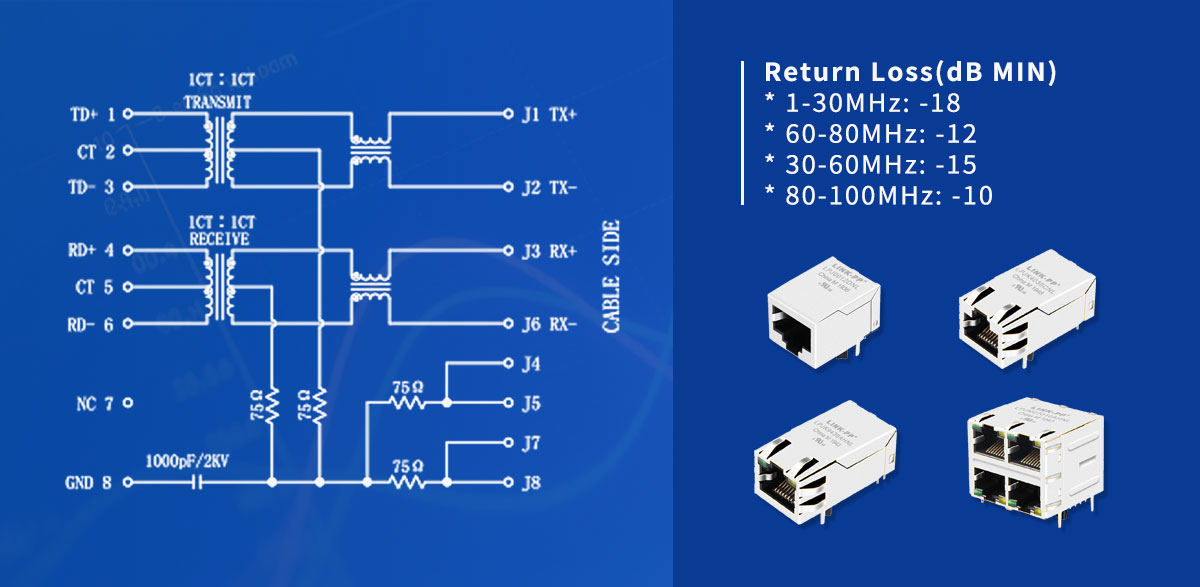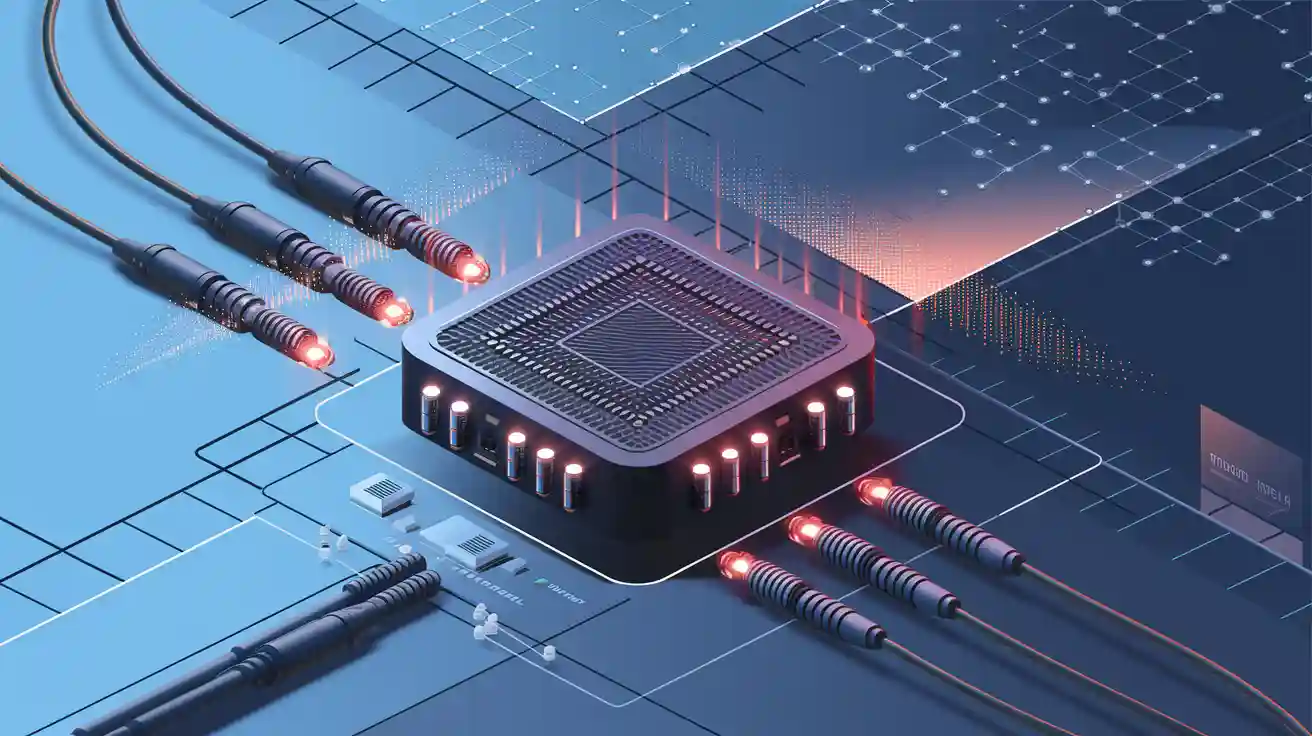In Ethernet hardware design, engineers often pay close attention to signal integrity metrics like crosstalk, insertion loss, and EMI shielding. But one parameter is frequently misunderstood despite its critical impact: Return Loss. When working with high-speed RJ45 connectors with integrated magnetics (MagJack), understanding return loss is essential to ensure system stability, efficiency, and compliance with IEEE 802.3 standards.
In this article, we’ll break down what return loss means, why it matters in RJ45 MagJack design, and how LINK-PP products—from 10/100 Base-T to 10G—are engineered to meet these demanding requirements.
What Is Return Loss?
Return loss is a key signal integrity parameter that quantifies how much of a transmitted signal is reflected back due to impedance mismatch in a transmission line. It is measured in decibels (dB) using the formula:
Return Loss (dB) = -20 * log10(|(ZL - Z0) / (ZL + Z0)|)

where Zload is the load impedance (e.g., connector or PHY input), and Z0 is the characteristic impedance of the medium—commonly 100Ω for Ethernet applications using unshielded twisted pair (UTP) cables, as standardized by IEEE 802.3-2018, Clause 40.7.1.
In general, a higher return loss value indicates less reflected energy, which translates to better impedance matching and signal quality. However, return loss does not need to be maximized arbitrarily—compliance with IEEE minimum return loss thresholds across the specified frequency range is the primary design goal.
📘 IEEE 802.3-2018 defines minimum return loss performance criteria for 100BASE-T, 1000BASE-T, and 10GBASE-T interfaces in clauses 14, 40, and 55, respectively. For example, 1000BASE-T requires minimum return loss of -16 dB from 1–30 MHz.
Proper impedance matching across connectors, cables, and PCB traces ensures efficient power transfer and minimizes data-dependent jitter, especially in high-speed applications such as 2.5G/5G/10G Ethernet, or when combined with Power over Ethernet (PoE) systems that introduce additional common-mode current paths.
Why Return Loss Is Important in Ethernet
In high-speed Ethernet applications, signal integrity is not just about sending data—it's about ensuring that data arrives cleanly. If return loss is too low (i.e., too much reflection), the system may fail compliance testing or become unstable in real-world conditions.
For example:
Poor return loss can increase jitter and packet loss
Excessive reflections may interfere with differential signaling, especially in PoE applications
Standards such as IEEE 802.3 require minimum return loss levels at specific frequency bands to ensure proper function
Return loss becomes more critical at higher frequencies. That’s why connectors for 2.5G, 5G, and 10G Ethernet must have tighter control over impedance and construction quality.
Return Loss Performance in LINK-PP RJ45 Connectors

LINK-PP offers a comprehensive range of RJ45 MagJack connectors engineered to meet or exceed Ethernet return loss specifications. Below are examples from four representative products:
🔹 LPJ0012DNL – 10/100 Base-T Ethernet MagJack
Ideal for SOHO and legacy Ethernet systems
Return Loss (dB Min):
1–30 MHz: -18
30–60 MHz: -15
60–80 MHz: -12
80–100 MHz: -10
This connector offers excellent signal reflection suppression within the range required by 100BASE-TX protocols.
🔹 LPJK4036CNL – Gigabit RJ45 Magnetic Connector
Used in switches, routers, and embedded LAN applications
Return Loss (dB Min):
1–10 MHz: -20
30 MHz: -16
60–80 MHz: -12
80–100 MHz: -10
This connector demonstrates strong impedance matching, especially at low frequencies, suitable for 1000BASE-T.
🔹 LPJM27010AHNL – 2.5G 2x2 Port RJ45 Connector
Designed for modern IoT gateways and edge devices
Return Loss (dB Min):
1–30 MHz: -16
30–100 MHz: -12
100–150 MHz: -10
A well-balanced performance for 2.5GBASE-T, where signal control becomes more sensitive above 100 MHz.
🔹 LPJK9436AHNL – 10G Base-T RJ45 MagJack
For high-speed backbone devices and 10G switches
Return Loss (dB Min):
1–40 MHz: -18
40–400 MHz: -8
400–500 MHz: -5
Even in ultra-high-frequency operation, this connector meets the stringent demands of 10GBASE-T Ethernet links.
How to Evaluate Return Loss in Connector Selection
When choosing a connector, pay attention to:
The frequency range your system operates in
The minimum return loss (in dB) across that range
Whether the connector meets IEEE 802.3 return loss specs for your speed class
Manufacturer testing and consistency across batches
At LINK-PP, all RJ45 MagJack products are 100% tested and compliant with industry standards, with in-stock availability and fast global delivery.
Conclusion
Return loss is not just a number—it's a measure of how well your network hardware is engineered to carry data without loss or interference. From 10/100 Ethernet to 10G applications, proper control of return loss ensures signal clarity, stability, and compliance.
Whether you're designing next-generation routers or reliable embedded systems, LINK-PP RJ45 connectors offer the performance and assurance required for mission-critical networking.
👉 Explore our full range of integrated RJ45 connectors at:
🔗LINK-PP Website
📩 Need help selecting the right part? Contact us for datasheets, samples, or custom recommendations.


